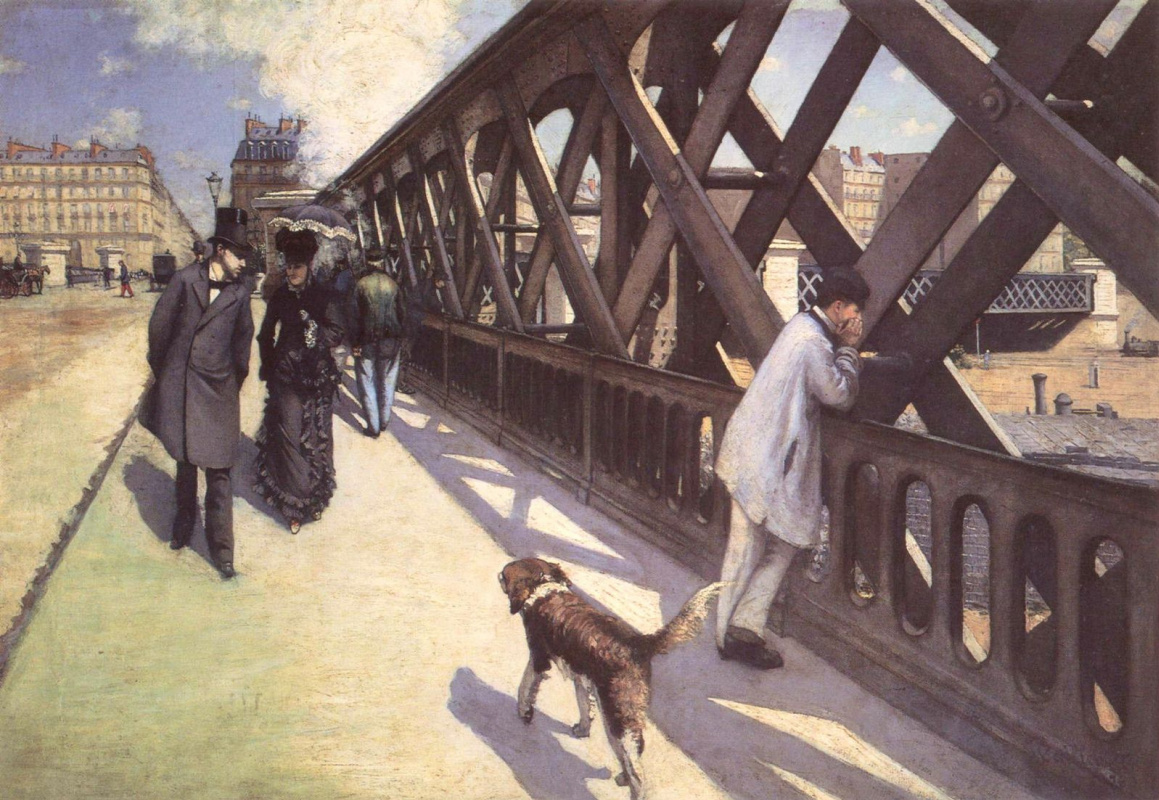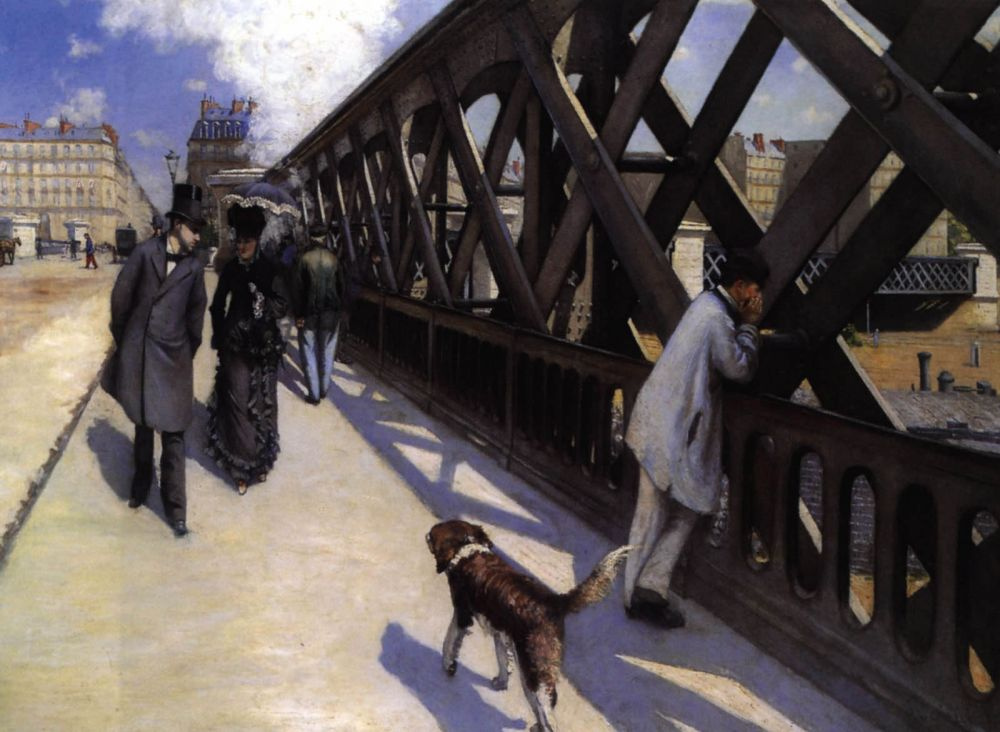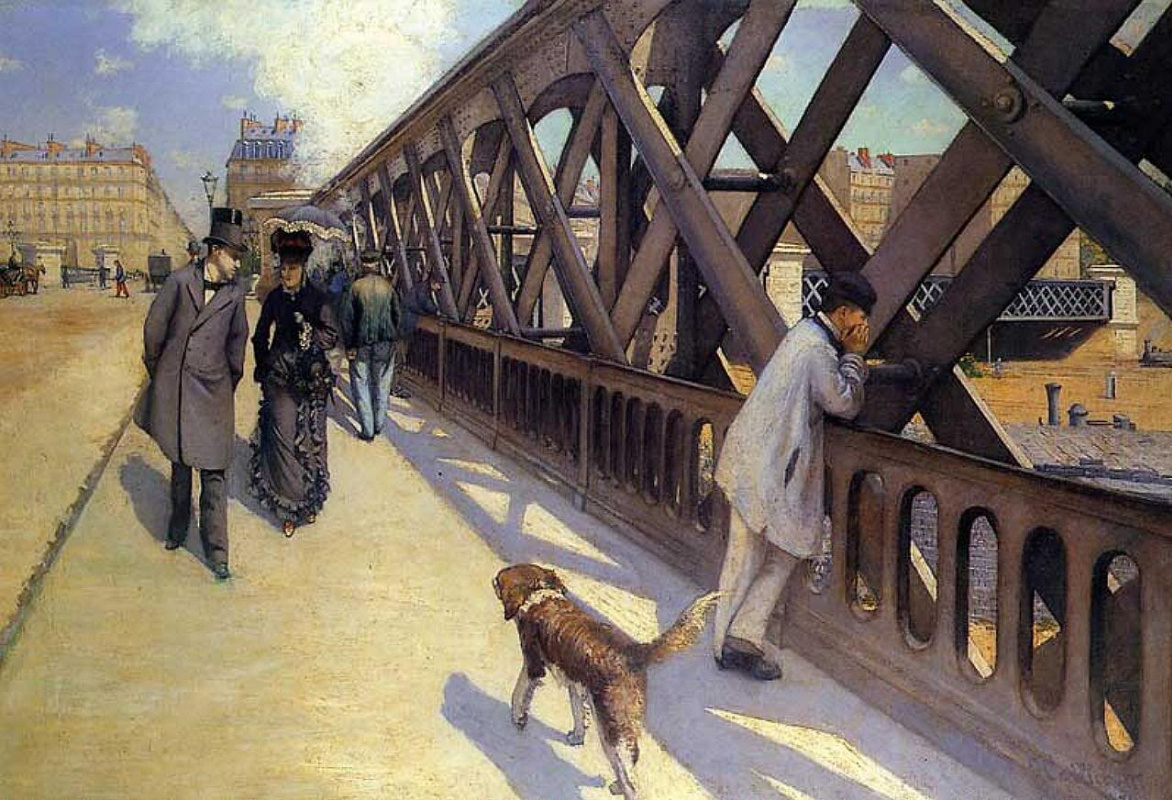log in
Enter site
Login to use Arthive functionality to the maximum
The Europe Bridge
Gustave Caillebotte • Painting, 1876, 125×181 cm
Description of the artwork «The Europe Bridge»
The Europe Bridge was the most modern place one could find in Paris in the 1870s. It was only ten years old; in the middle of the bridge, there was a square with 6 wide new streets converging. Under a heavy, mighty bridge, trains left and arrived from
Saint-Lazare station. Le Pont de l’Europe — The Europe Bridge is a painting by Caillebotte the engineer, who was ready for impressionistic artistic experiments in depicting the background, a sunlit road, smoke rising above the bridge, but was not ready to sacrifice a single powerful, heavy bolt in the precisely built structure of the bridge itself. Caillebotte admired it.
These noisy, crowded, stunning places in the new rebuilding Paris blur the boundaries between the social strata and promise new impressions every new moment. Everyone can enjoy the rumble, smells and monumental forms of the new world: workers, priests, prostitutes, idlers, rich and poor, Parisians and provincials. Everyone has different ways to follow here, but no one bothers anyone.
It was as if we saw the man and the woman on the Europe Bridge by chance, looking back at a loud sound or voice. They are not a couple, something was happening between them a second ago, but now it is not clear what exactly. Some modern critics find a multilevel seduction game here. The rich man, avoiding the attention of the woman (most likely a prostitute), turns an almost interested look at the man-worker leaning on the railing of the bridge. Caillebott’s suspicions of homosexuality, which have not yet been proven, are most often based on his bachelor life, short romances, a special interest in male nature and little attention to the depiction of women.
When the painting was first presented at the Third Exhibition of the Impressionists in 1877, anyone hardly looked for such ambiguous implications in it. Scandalous and innovative was just the choice of the subject and the figures based on their social characteristics. Anne Distel, a French honorary general curator of heritage at the Musée d'Orsay and specialist in Impressionist paintings, claims that with this painting and several others, Caillebotte began a new art, corresponding to naturalism in literature.
Caillebotte painted two more sketches for The Europe Bridge (one is kept in a private collection, the other is in the Museum of Fine Arts in Rennes) and another painting, On the Europe Bridge (the same construction of the bridge, but at an extremely close distance, almost an engineering drawing). And judging by all these variations, for Caillebotte the artist, engineer, gardener, rower, the main subject of the picture was still the bridge, which was the most modern, unpredictable and mesmerizing place in the new Paris.
Written by Anna Sidelnikova
Saint-Lazare station. Le Pont de l’Europe — The Europe Bridge is a painting by Caillebotte the engineer, who was ready for impressionistic artistic experiments in depicting the background, a sunlit road, smoke rising above the bridge, but was not ready to sacrifice a single powerful, heavy bolt in the precisely built structure of the bridge itself. Caillebotte admired it.
These noisy, crowded, stunning places in the new rebuilding Paris blur the boundaries between the social strata and promise new impressions every new moment. Everyone can enjoy the rumble, smells and monumental forms of the new world: workers, priests, prostitutes, idlers, rich and poor, Parisians and provincials. Everyone has different ways to follow here, but no one bothers anyone.
It was as if we saw the man and the woman on the Europe Bridge by chance, looking back at a loud sound or voice. They are not a couple, something was happening between them a second ago, but now it is not clear what exactly. Some modern critics find a multilevel seduction game here. The rich man, avoiding the attention of the woman (most likely a prostitute), turns an almost interested look at the man-worker leaning on the railing of the bridge. Caillebott’s suspicions of homosexuality, which have not yet been proven, are most often based on his bachelor life, short romances, a special interest in male nature and little attention to the depiction of women.
When the painting was first presented at the Third Exhibition of the Impressionists in 1877, anyone hardly looked for such ambiguous implications in it. Scandalous and innovative was just the choice of the subject and the figures based on their social characteristics. Anne Distel, a French honorary general curator of heritage at the Musée d'Orsay and specialist in Impressionist paintings, claims that with this painting and several others, Caillebotte began a new art, corresponding to naturalism in literature.
Caillebotte painted two more sketches for The Europe Bridge (one is kept in a private collection, the other is in the Museum of Fine Arts in Rennes) and another painting, On the Europe Bridge (the same construction of the bridge, but at an extremely close distance, almost an engineering drawing). And judging by all these variations, for Caillebotte the artist, engineer, gardener, rower, the main subject of the picture was still the bridge, which was the most modern, unpredictable and mesmerizing place in the new Paris.
Written by Anna Sidelnikova








